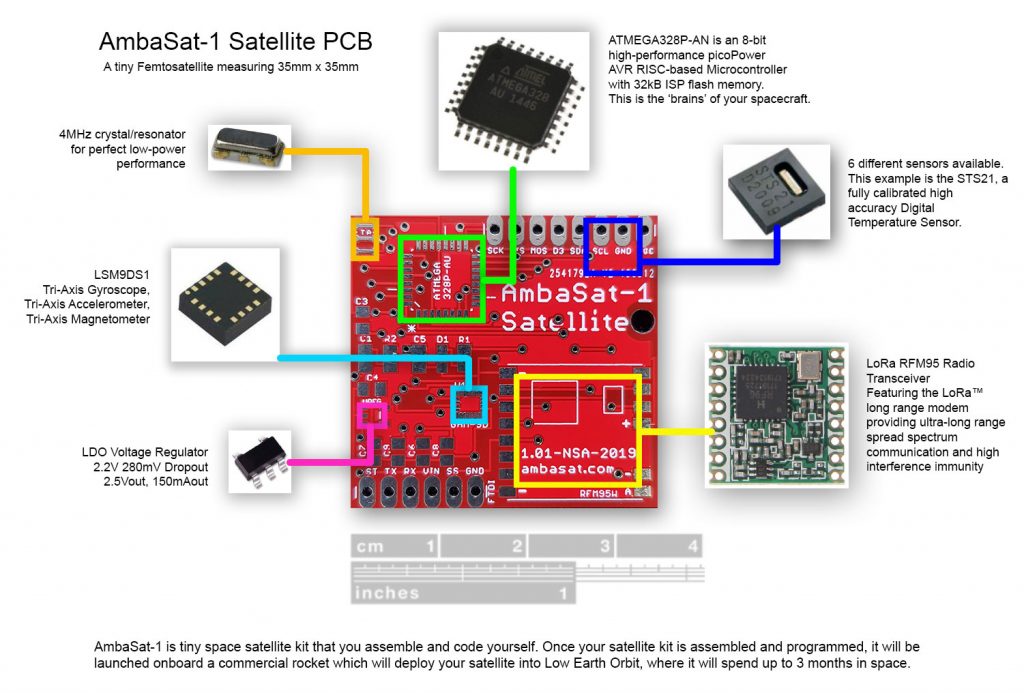AmbaSat-1 is tiny spacecraft kit that you assemble and code yourself.
Once your satellite kit is assembled and programmed, it will be launched onboard a commercial rocket which will deploy your satellite into Low Earth Orbit, where it will spend up to 3 months in space.
AmbaSat-1 is part of a new generation of satellites known as Sprite satellites. They are tiny spacecraft measuring 35 mm square and just a few millimetres thick. Pioneered by the original KickSat, groups of AmbaSat-1 satellites are launched onboard a commercial rocket. By shrinking the spacecraft, up to 200 satellites can be launched at a time, reducing costs.
Making use of The Things Network (TTN), AmbaSats are capable of transmitting data to over seven thousand earthbased TTN receivers (Gateways) which are spread around the whole globe. No specialist radio receiving equipment is required, your data appears over the internet directly to your AmbaSat Dashboard.
AmbaSats are just a little bigger than the size of a couple of postage stamps but have solar cells, a LoRaWAN radio transceiver, microcontroller (an Arduino compatible ATMEGA 328P-AU), memory, a gyroscope, accelerometer, magnetometer as well as a range of other sensor options.
What’s in the AmbaSat Kit?
- AmbaSat PCB – the main board where all the components are placed, including the MCU (Micro Controller Unit)
- Micro Controller Unit – the brains of AmbaSat. This is where your code lives
- Solar Panels – Spaceflight approved solar panels providing power to your satellite
- Transceiver – The radio communications chip. This is the chip which will send data back to Earth and into your AmbaSat Dashboard
- FTDI board – this is used for coding and converts your USB port to serial
- Gyroscope, Accelerometer, Magnetometer – used to locate your satellite in space
- A bag of parts containing resistors, capacitors, voltage regulator and other components
- Your chosen sensor
Software Coding (Programming the Satellite)
AmbaSat-1 is fully Arduino compatible and code is written using C/C++
Whether you’re new to the ‘C’ language or a seasoned pro, we have all the libraries, example source code and interfaces you need to get your satellite flying.
The AmbaSat kit comes complete with a FTDI USB adapter allowing direct coding in the Arduino IDE (based on C/C++). It’s the most popular programming environment for makers and hardware enthusiasts. AmbaSat is fully compatible with all Arduino related code examples. That’s because your satellite uses the well-respected Atmel ATMEGA-328 which is exactly the same microprocessor used by Arduino. In fact, your satellite is compatible with all online Arduino software libraries and your code will work with Arduino shields and modules with little or no library code modifications.
Never coded before? Don’t know the first thing about hardware? That’s no problem. The AmbaSat Kit build will take you from learning how to use a soldering iron all the way through to assembling and coding your very own satellite. We’ve created a detailed step-by-step learning process:
Step 1. Unpacking your kit: What’s inside. The basics
Step 2. Electronics basics: Resistors, capacitors, MCU and other components
Step 3. Your toolbox: What you need. How to use it
Step 4. Assembly: The hardware and PCB. Putting it together
Step 5. Introduction to coding: Welcome to Arduino (C/C++). Let’s get your satellite coded
Step 6. Your AmbaSat Dashboard: Connecting to your Dashboard. Sending data from your satellite
What can I do with my satellite? Measure! Explore! Measure!
What better way of showing off your uber-cool geekness than building your own spacecraft?
Your AmbaSat is fun but it’s also practical. Maybe you’re just looking to put your very own spacecraft into space. That’s great and also very cool. You can program it to send any message back to Earth that you like. However, if you’re looking for practical applications, including studying the environmental impact of gases, radiation, global warming, etc then read on!
Every AmbaSat comes loaded with a gyroscope, accelerometer and magnetometer sensor. These sensors come in the form of an integrated chip (IC) which is called the LSM9DS1. In low Earth orbit, there is no GPS signal available so this chip helps plot your satellite’s orbit in space. It’s a versatile, motion-sensing system-on-a-chip. It houses a 3-axis accelerometer, 3-axis gyroscope, and 3-axis magnetometer – nine degrees of freedom (9DOF) in a single IC. See the LSM9DS1 overview section for more details on what this fantastic IC can do. In addition to the LSM9DS1, when you select your AmbaSat kit, you get the option to choose which type of additional sensor you would like to fit onto your satellite.
AmbaSat is Open Source We’ve learned a lot from the open source community. Electronics, hardware, coding, software libraries and much more.
So, we want to give our work back to the maker and open source community.
The AmbaSat satellite software is fully open-source and available for full download. The AmbaSat satellite hardware is also totally open source and the schematics and Bill of Materials (BoM) are available for download.
What this means is that you can fully use all the above and create your own version of the AmbaSat satellite. Go ahead and use the schematic and source code and create your very own space satellite.
Come and join the journey at ambasat.com
